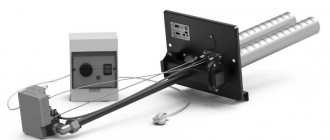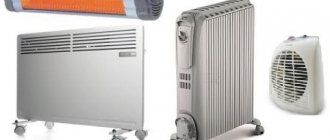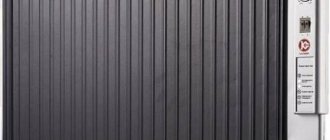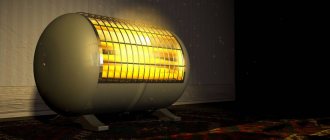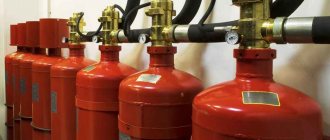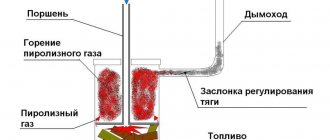To create a normal temperature regime in everyday life and at work, various types of heating devices are used. Depending on the installation location, they can be either temporary or permanent, and according to the principle of operation they are divided into convection and infrared. Convection models are classic and have been used by mankind since time immemorial, but today their use is not always advisable. Therefore, an infrared gas heater, which has significant advantages, is increasingly used to heat rooms.
Purpose
The main purpose of an infrared heater is to expose any absorbing surface to the rays it produces. Such surfaces include any objects around you that absorb light energy, that is, not transparent and the person himself. Due to this property, heating of the surrounding air space is a side effect of the operation of an infrared heater, when thermal energy from heated objects is transferred to the air. This determines the main advantage over classical systems - direct impact on a specific area and the absence of such large losses.
Rice. 1: fundamental difference in heating
In practice, an infrared gas heater is designed to heat any space in places where it is not possible to connect electric convectors to the network or where power supply is impractical.
As specific examples, an IR heater can be used for:
- Heating of gazebos and tables in nature, in park areas and recreation areas, etc.;
- Heating tents in the cold season from a gas cylinder;
- Heating garages to ensure comfortable working conditions;
- Heating of residential premises in summer cottages;
- Ensuring temperature conditions in the working area of industrial premises;
- Heating of greenhouses, chicken coops and nurseries for livestock;
- Heating any area in the open air (at construction sites, quarries, geological exploration sites, terraces, etc.).
Also, using this type of gas heaters, various surfaces can be dried and heated. An important advantage of an infrared gas heater is the use of a special element for burning fuel and producing infrared radiation. This feature makes its operation identical to that of electrical appliances, with the difference that it can function regardless of the presence of a centralized fuel source.
The best outdoor heaters
When it is necessary to heat an open space on the street (a picnic in nature or gatherings in a yard gazebo in spring and autumn), then gas-powered outdoor heaters are used. They feature a stylish design and a tall body to distribute heat over a large area. Below are the models most liked by users.
Siabs Kaliente – elegant heating
One of the most beautiful and expensive types of outdoor heater is Siabs Kaliente. This Italian unit rises 233 cm and is a vertical piece of equipment that resembles a miniature Eiffel Tower. The heater's power is 10.5 kW, and its heat-covering capacity will cover 35 square meters. The body materials are aluminum and stainless steel.
The lower part has LED lighting for decoration. The weight with a filled cylinder will be 33 kg. Continuous operation will last for 10-18 hours, depending on the set mode. The flame burns in a closed flask under glass. This gives a beautiful effect and warmth in the form of infrared radiation. High quality body assembly. Stands firmly on the ground.
Advantages:
- very beautiful design;
- economical gas consumption;
- stainless materials;
- good stability;
- safe;
- one-piece protective grille.
Flaws:
- The packaging stickers on the case are difficult to peel off;
- high price;
- There is a lot of unnecessary technical information in the passport.
READ ALSO
5 best heaters for a summer house
ENDERS Elegance – for a cozy holiday with a small group
This German heater is much cheaper than its analogues and is designed for a radius of only 9 meters. The design of the device resembles a street lamp with a fungus. The height of the structure reaches 220 cm. The case material is polished stainless steel. It is practical to install it in the center of a gazebo or yard. The power of the device is 8 kW. The gas combustion consumption is almost 600 g per hour.
Among the functionality there is a pressure regulator that monitors the maintenance of the flame. In the absence of fire, leakage protection is activated. Due to the high narrow design, there is a tilt sensor that cuts off the fire in the burner if it falls. With a filled standard cylinder, the device will burn from 19 to 50 hours, depending on the selected mode.
READ ALSO
5 best carbon heaters
Advantages:
- anti-corrosion body material;
- beautiful unique design;
- leakage and tilt protection sensors;
- possibility of use on a covered terrace if the ceiling is more than 75 cm;
- easy assembly;
- affordable price.
Flaws:
- small heating area;
- ineffective in windy weather.
ACTIVA Pyramide Cheops 13600 – heating pyramid
As the name itself suggests, this heater is created in the style of a pyramid, which has a narrow, towering shape. The flame burns in a durable flask, closed with four meshes. On one side there is a hinged cover that provides access to the cylinder installation location, the piezo ignition button and the adjustment switch.
Design and operating principle
Structurally, an infrared gas heater includes a metal casing in which gas distribution equipment, automatic protective devices and a heat emitter are assembled. The principle of its operation is similar to a gas burner, but unlike conventional burners, there is no classical gas combustion here.
Rice. 2: operating principle of IR gas heater
Look at the picture, it shows the principle of operation of an infrared gas heater. When gas is supplied, it enters the diffuser, where it is picked up by a stream of air and directed into the mixing chamber, where a combustible mixture is formed. After this, the gas mixture enters the perforated porous structure of the ceramic plate. After a spark is supplied from the piezoelectric element, the mixture in the holes ignites and transfers thermal energy to the ceramic element.
Next, the heated ceramic plate heats up to a temperature of 900ºC and begins to emit waves in the infrared range. The ceramic emitter itself does not transfer heat to the surrounding space, like a convector, but directs the flow of infrared radiation into the heating zone. Such a zone is strictly limited in its geometric parameters, and the gas heater has a directional effect. All objects and people falling within the range of infrared radiation will be heated by the flow.
Top 5 best tent heaters
In winter, a short stay in a tent or overnight stay requires certain conditions, which only the best heater can organize. With the right choice, the device will create an atmosphere of warmth and comfort in the tent, contributing to a more comfortable stay. In addition, the heater is indispensable for winter fishing.
Now there are several types of tourist heaters on the market; they can be roughly divided into groups:
- Gas - according to user reviews, these are the most popular models that will save you even in severe frost. They are multifunctional and compact. When camping, a gas heater serves both as a heating element and as a place where food is prepared. However, it should be borne in mind that the fuel in the burner is enough for a short hike.
- Gasoline heaters are much cheaper than gas heaters, but you cannot cook with them; their function is exclusively heating. A significant advantage is the quick and affordable refueling of the device, thanks to which it will work exactly as long as needed.
- Ceramic infrared heaters are the smallest and lightest heaters, which is optimal for winter fishing or hiking. The room is heated by heating the built-in ceramic plate through the action of an infrared emitter - the latter is activated by burning gas in a burner.
When using heaters, it is very important to remember fire safety rules. To find out what equipment is best to take with you on a fishing or hiking trip, just look at the rating of the best tourist heaters for tents.
Classification
It should be noted that not all gas heaters operate according to the above principle. Depending on the method of obtaining thermal energy from blue fuel, gas heaters are divided into three main classes:
- Gas convectors - have a burner design and operate on the principle of a gas gun. When fuel burns, thermal energy is generated, which is directed by a fan into the desired area. The disadvantage is the presence of an open flame and relatively large losses.
- Catalytic heaters - their distinctive feature is the presence of a catalytic panel that converts fuel into thermal energy through its oxidation. In such devices there is no combustion process, so they are the safest and most environmentally friendly heat sources. But their main disadvantage is the relatively high cost of the panel itself. Therefore, heaters operating on the principle of catalytic combustion are purchased relatively rarely.
- Infrared heaters emit directed IR radiation from a ceramic burner. Unlike the previous type, they still require gas combustion, but are capable of generating greater thermal power and are characterized by a significantly larger heating area.
Rice.
3: design of an infrared gas heater Comparing the above types of gas heaters, it can be noted that catalytic and infrared have significant advantages over a classic heating device. Of these two, catalytic ones are preferable for rooms with a square area of up to 20 m2. Over 20 m2, infrared heaters have an indisputable advantage, so they can be used not only as a room heating system, but also as outdoor heaters.
The classification of infrared gas heaters can be divided according to several criteria. So, all devices can be conditionally divided into two main groups: autonomous and operating from main gas pipelines. The first of them require the installation of a gas cylinder, which recharges the heater; they can be taken with you outdoors to heat tents. The latter must be powered from a central gas pipeline and cannot move from place to place, to new facilities without connecting the gas supply system to this point.
By type of placement, infrared gas heaters are divided into:
- Floor-standing – which are installed on horizontal surfaces using a special stand or using structural elements;
Rice. 4: floor standing IR gas heater - Ceiling – suspended from the ceiling directly above the area that needs to be heated, such models allow you to save space in rooms with a small square footage, since they themselves do not occupy useful space;
Rice. 5: Ceiling IR gas heater - Wall -mounted ones are identical to previous gas heaters with the difference that the infrared radiation from them can be directed to the desired location, both near the device and at the other end of the room, and not just under the gas heater.
Operating principle of a catalytic gas heater
The operation of a catalytic heater is based on the release of thermal energy through the process of fuel oxidation on the surface of the catalyst. Gas or gasoline is used to operate, and the catalyst is a plate made of fiberglass with a thin layer of platinum powder. The surface of the plate consists of a huge number of small holes through which fuel enters and burns.
The process of operation of a catalytic heater is also called “surface combustion”. The product plate can heat up to +500°C. Despite this, its operation is safer and more environmentally friendly than with traditional open flame combustion.
The advantage of heating rooms with a catalytic gas heater is the complete combustion of fuel without the formation of an intermediate combustion product - carbon monoxide. Despite its low emission level, the heater should be installed in a well-ventilated area. The diameter of the ventilation holes in such a room must correspond to the power of the catalytic heater (from 25 cm2 per 1000 W)
The catalytic plate is designed for 7-8 years of continuous operation, after which it should be replaced.
The heater consists of the following structural elements:
- catalyst. This is the main element in the form of a plate.
- housings;
- low power gas burner;
- heat exchangers;
- heating elements;
- refillable gas cylinder.
In most cases, the body is made of metal and a container with fuel is placed in it. When traveling and hiking, devices without a housing are used. They are compact and easy to move.
Portable catalytic gas heater
Additional elements may include a thermostat, a built-in ignition device, and automatic shutdown.
According to the type of design, there are installations with a container for liquefied gas built into the housing. The maximum amount of gas inside such a device can reach 27 cubic meters
Advantages and disadvantages
The great popularity of such devices is due to their significant advantages in comparison with heaters of other operating principles.
The advantages of infrared gas heaters include:
- Much higher efficiency - about 80%, in comparison with the same convectors;
- Provides fuel savings from the same standard cylinders or main system;
- Forms a heat flow at the desired angle, but at a distance of no more than 60m;
- It has compact dimensions and ergonomic design;
- Does not require special skills and knowledge for installation; ease of operation is comparable to conventional household appliances;
- High degree of safety, since the device is equipped with a fall or tip-over protection system, carbon monoxide level measurement, and a gas monitoring system;
- Autonomy - infrared heaters powered from gas cylinders are not afraid of interruptions in the supply of energy resources, and those operating from the main gas pipeline are not afraid of power outages.
But, along with the above advantages, such a device is also characterized by some disadvantages.
The disadvantages of infrared gas heaters include:
- The presence of an open source of flame and high temperature, which limits the possibility of their use in fire and explosive areas, near flammable objects;
- During the combustion process, oxygen is consumed and carbon monoxide is released along with chemicals formed from fuel combustion, which deteriorates the quality of indoor air;
- Requires cleaning and maintenance work for the infrared emitter after processing a certain amount of fuel;
- The relatively high cost of such a gas heater.
It should be noted that an infrared gas heater is the most optimal device for heating rooms with a large area and high ceilings.
Flaws
- For stable operation you will need gas. And if there is no centralized pipeline nearby, you will have to use gas cylinders that require periodic refilling.
- Large and functional models are quite expensive.
- To install in an apartment or house, you will need to carry out additional work and install a gas hose. The bottom line is that a gas heater requires operation with a gas cylinder or a centralized line. Therefore, take this factor into account; it will not provide much ease of use.
- To operate a gas heater, the room must be ventilated. It is not possible to provide good heating with just one device.
- It is not recommended to use a gas heater in rooms where there are small children.
- The device requires periodic maintenance and preventive maintenance. During operation and in the process of converting gas into thermal energy, many structural elements fail.
- A gas heater is a high-risk device. In addition to the possibility of fire, there is the threat of a gas explosion. This topic was fully covered by my colleague in his article “Tragedies with Domestic Gas Explosions . I advise everyone to read this material by clicking on this link.
Criterias of choice
When choosing a specific model for heating, you should pay special attention to the parameters of the infrared gas heater. The first of these is the type of fuel received - bottled gas or main gas. For the first option there are no special connection conditions, but for the second it is necessary to ensure the supply of all communications.
The second parameter is the power of the device. Consider this criterion in more detail, the calculation is made based on the ratio of 1 kW of power for every 10 - 15 m2 of area, depending on the distance of the infrared heater from a specific surface. So, based on the proposed ratio, 4 kW models can be used for rooms with an area of 40 - 50 m2. In the open air, an infrared gas heater is selected in accordance with local characteristics and tasks, but the ratio of power and area remains the same.
Along with the thermal power, take into account gas consumption, since their ratio may differ for different models of infrared heaters. Choose the most optimal flow rate for your situation. It should be noted that this parameter depends not only on the internal device, but also on the type of gas used.
In matters of durability, the ceramic element is considered the most relevant component, since the durability and quality of operation of the entire heater depend on its characteristics.
How to choose a gas infrared ceramic heater
Before you buy a gas infrared heater for your cottage or home, you need to familiarize yourself with a number of characteristics that determine the purpose of this device. Depending on the power, as well as design features, each option is most suitable for specific operating conditions.
The main guideline when choosing infrared gas heaters is their safety, so here you should exercise maximum caution and attentiveness. A mandatory requirement for the purchased model is a built-in automatic shutdown system, which is triggered when the product overturns or is strongly tilted. Today, such a security measure is considered mandatory.
Note! Another useful feature is the automatic shutdown of the gas supply in case the burner is accidentally extinguished.
Where exactly the heater is planned to be placed also plays a major role in the choice. So, for residential premises it is necessary to have a special sensor that will indicate the level of carbon dioxide in the room. After all, during the combustion process carbon dioxide is released, which can accumulate. In large quantities, it is unsafe for both health and human life.
Ceramic heating element for gas heater
If there is a special sensor, the level of carbon dioxide in the room is regulated as follows: the device regularly takes a sample, determining the current level. At the same time, he checks it against the given boundary. If the current level has reached the limit, the device automatically switches off.
How to choose an infrared heater for your garden
In order to buy a gas infrared ceramic heater, you need to focus on the mode in which you plan to use it. Perhaps you will turn it on periodically when you come to the country for a few days. If long-term operation is planned, then the efficiency of the device will play a significant role, because its continued use will entail certain costs.
When choosing an infrared heater for your dacha, be sure to pay attention to the power of the device. There is a simple rule that you have to take into account: the more powerful the device, the less mobile it is. And, accordingly, vice versa. A simple and lightweight device will never be able to produce the same power as a massive, bulky heater.
The choice in this case is not affected in any way by the total area of the room. After all, such devices do not heat the entire room, so its size does not matter. Think in advance where you will install the heater and what area it will need to heat.
Portable gas heater Kovea Cupid Heater KH-1203
Helpful advice! It is always better to purchase a heater with a power reserve and not use it at maximum mode. This way you can heat a larger area if necessary.
The appearance of the device will also play a big role, because everyone will want the heater to fit naturally into the environment and not create visual discomfort. Despite all its advantages, an infrared heater still cannot be considered a full-fledged heating device if we are talking about permanent residence in the house. Its use is fully justified as an alternative for short periods of time, or as an additional source of heat.
How to choose an infrared gas heater for the garage
Buying a gas heater for a garage is one of the most difficult tasks. After all, initially this room is filled with a large amount of flammable substances, which, in combination with such equipment, create a fire hazard. Therefore, more stringent requirements are imposed on the safety of gas equipment.
Gas heater is perfect as a heat source for the garage
According to the type of construction, portable models are considered the most suitable for a garage, since, if necessary, the direction of heat flow can be changed. In this type of room, it may be optimal to use a ceiling-mounted gas infrared heater.
Helpful advice! Think in advance about how the gas infrared heater will be serviced and repaired. There should be a free approach to all its elements.
Operating principle and application of gas convector
Convection is a well-studied physical phenomenon of flow movement due to the difference in the masses of cold and heated air. The first one enters the room, moves through doors, windows, cracks to the floor. Heating devices are also located here, heating cold air by passing it through its structural heating surface. Heated air with a lower density rushes upward, and new cold air layers move in its place, the process continues until temperature equilibrium is reached.
This is a very effective method of heat exchange, since it does not require a source, such as a fan, to move masses. In addition, the advantages of this type of heat exchange are:
- Simple design;
- developed heating surface;
- absence of overheated heating surfaces above 45 °C;
- mobility, the ability to change the location of the device;
- No need for piping.
What does a gas convector look like?
The main components of a convective gas heater:
- Protective metal casing with grille to ensure speed of entry and exit;
- gas heating component;
- automatic temperature maintenance system.
Gas convectors using bottled gas are divided according to the installation method into floor/wall-mounted, built into the floor or into the baseboard. They work with flammable energy, so when using it you must follow the rules for the safe operation of gas installations.
Operating principle of a gaseous fuel convector:
- Air is taken from the atmosphere through a coaxial flue laid in the wall. It is made of two concentrically located pipes, flue gases exit through the central one, and air enters through the interpipe space.
- Gas is supplied to the chamber from a main line or a gas cylinder.
- Cold air enters the convector from below due to natural circulation. For powerful systems, fans are sometimes installed for intensive air intake.
- The waste burnt gas is released into the atmosphere. The movement of cold air and hot flue gases occurs towards each other, that is, according to the counterflow principle, which allows the air entering the combustion chamber to be heated, thereby increasing the efficiency of the thermal process of the installation.
- Flue gases give off heat energy through convective heating surfaces to cold air, which, when heated, rises to the top, sucking cold air into its place. The positive thing about this process is that the two air environments do not come into contact with each other, that is, the process occurs without mixing the media.
Nuances of calculations
Knowing the monthly gas consumption, you can determine the annual need for gas fuel. These calculations are valid for main gas and will differ slightly for liquefied gas. The heating season depends on the geographical location of the installation. It is determined in a tabular manner according to SNIP 01/23/99 “Construction climatology and geophysics”. For example, for the city of Moscow – 214 days.
Calculation of gas for heating: 36.96 X214 = 7909 m3, although in fact this is the maximum possible consumption, since the minimum outdoor temperature in winter will only be a few days, and the average temperature will be much higher. And it is she who will determine the actual fuel consumption. But to select equipment, the maximum calculation is taken to ensure reliable operation of the heater at the lowest temperatures.
Convector using bottled gas
This gas convector has its own characteristics that must be taken into account when choosing a model. The most optimal version of the device with a cast iron heat exchanger and control unit.
Similar to natural gas, power is also taken into account here, but you need to understand that these units are space efficient, so a separate one is installed for each. For apartments, devices with a closed chamber with a coaxial chimney are recommended, but even then it is not allowed to be installed in a multi-storey building due to the high explosion hazard of cylinder installations.
Convector using bottled gas
Many home owners equip such heating along with the installation of gas tanks that are filled with gas for the entire heating season.
Calculations for determining the volume of required gas are similar to those above, except that the lowest specific heat of combustion of liquefied gas is assumed to be 12.8 kW/kg, and the efficiency is 0.92. For the above example, heating a house with an area of 150 m2, calculation of the need for liquefied gas:
15 / 12.8 x 0.92 = 1.27 m3 / h of liquefied gas.
Daily consumption is 1.27 x 24 = 30.57 m3, and
Monthly consumption – 30.57 x 30 = 917 m3 As is obvious, in the case of using liquefied gas it will be required less per month by almost 170 m3. However, this does not mean that in general such heating will be cheaper, since its cost is much higher than main gas. In addition, liquefied gas is inferior to natural gas in many other respects, so liquefied gas convectors are installed only in areas where there is no central gas supply.
Gas convector on natural gas
This model is preferable for autonomous heating, but in order for it to work effectively, you need to know the differences and advantages of the modifications that are sold through the distribution network. After determining the required power of the unit, the next thing you need to pay attention to is the installation method, which can be wall-mounted or floor-mounted. The former are small in size and weight, while being quite efficient, but are limited by a productivity of 10 kW.
For heating large industrial premises, such as garages or repair shops, it is recommended to choose floor-mounted options. These models have a large weight and size due to the developed heating surface of the heat exchanger.
Modern gas convectors are equipped with closed combustion chambers. They are mounted together with a coaxial chimney. Due to the fact that air is taken from the street, they do not burn oxygen during the heating process, which creates positive sanitary and hygienic conditions in the room and is a huge plus, despite the increased cost of installation, up to 30% compared to open ones combustion devices.
The best gas heaters for home, cottage, apartment
While there is no heating system in a new house or repairs are being made to old lines, a gas heater will come to the rescue. For such cases, models with a catalytic afterburner of combustion products are required.
Bartolini Pullover K Turbo Plus
Rating: 4.
Thanks to its high performance, the Bartolini Pullover K Turbo Plus gas heater can become either an additional or the main source of heat. The model took first place in our rating due to its high thermal power (minimum 1.6 kW), which is enough to heat a room of up to 100 square meters. m. At the same time, the device consumes blue fuel quite economically (0.33 kg/h).
A platinum catalyst provides clean and safe exhaust. Therefore, when a mixture of gases (propane and butane) is burned, no odor is felt in the room. However, it is better to install the device next to a ventilation shaft. The device is designed simply, it can fit into the interior of any room.
Advantages
- high power;
- efficiency;
- presence of a catalytic panel;
- silent operation.
Flaws
- high price.
Ballu BIGH-55
Rating: 4.
Second place in the ranking went to the Italian heater Ballu BIGH-55, which is assembled in Russia. A special burner converts the oxidation of the gas mixture into infrared radiation. During operation, carbon monoxide is not generated, which makes using the device indoors safe. The device is designed to heat a room of 60 square meters. m. A positive feature of the heater is its low gas consumption (0.3 kg/h).
The manufacturer also took care of operational safety. The device is equipped with a carbon dioxide monitoring system, gas control, and when tipped over, it turns off automatically. The heater is lightweight (8.4 kg), although wheels are also installed for mobility.
Advantages
- stylish design;
- ceramic burner;
- safe operation.
Flaws
- problematic ignition from a new cylinder.
Timberk TGH 4200 M1
Rating: 4.
The Timberk TGH 4200 M1 gas heater produces a large heat flow. With its help you can heat a room of 60 square meters. m. Its high power (4.2 kW), affordable price and compactness were highly appreciated by experts, giving it third place in the rating. The heating intensity has a 3-stage adjustment, all controls are located in the upper part, which is convenient and accessible for an adult. When the heater operates, the released energy is converted into infrared radiation.
The device has such modern functions as piezo ignition, carbon dioxide content controller, gas control, and rollover protection. It was not possible to overtake the leaders due to incomplete combustion of gas, as evidenced by user reviews.
Advantages
- high efficiency;
- economical gas consumption;
- high-quality manufacturing;
- low price.
Flaws
- fuel does not burn completely;
- unstable position.
